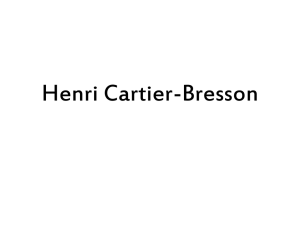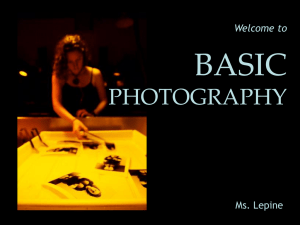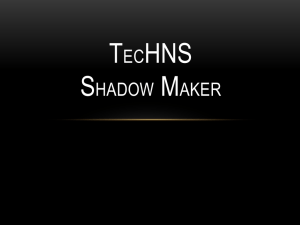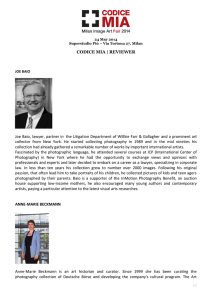Basic Camera Techniques
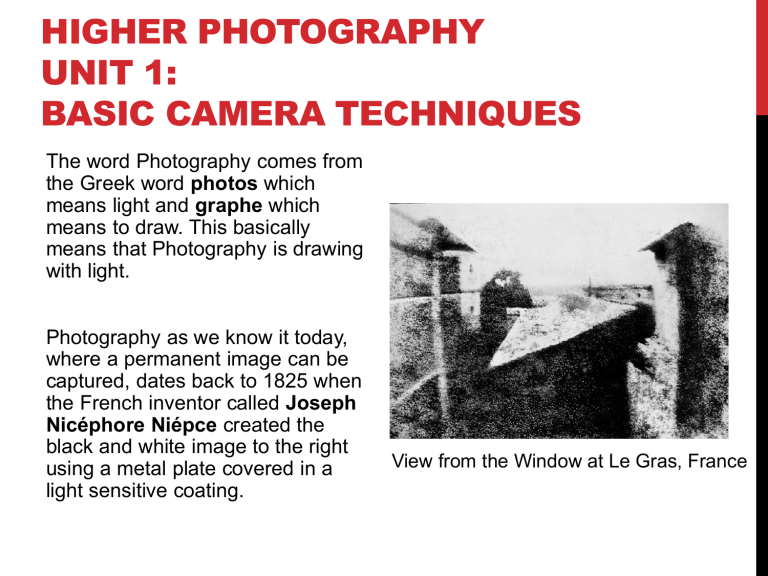
HIGHER PHOTOGRAPHY
UNIT 1:
BASIC CAMERA TECHNIQUES
The word Photography comes from the Greek word photos which means light and graphe which means to draw. This basically means that Photography is drawing with light.
Photography as we know it today, where a permanent image can be captured, dates back to 1825 when the French inventor called Joseph
Nicéphore Niépce created the black and white image to the right using a metal plate covered in a light sensitive coating.
View from the Window at Le Gras, France
HIGHER PHOTOGRAPHY
UNIT 1:
BASIC CAMERA TECHNIQUES
The first colour image was produced in 1861 by the Scottish physicist James Clerk Maxwell and was produced by projecting three images, one red, one blue and green which when combined created the image to the right.
Digital photography which we use today (photography without the use of film or chemicals) dates back to the 1970’s where Steven
Sasson, and engineer at Kodak, used an image sensor instead of film.
HIGHER PHOTOGRAPHY
UNIT 1:
BASIC CAMERA TECHNIQUES
Light
Photography would not be possible without light. Light is a form of electromagnetic radiation which is visible to the human eye.
The study of light and how it interacts with different things is called optics and the area of optics is something which is very important to the creation of an image using a camera.
Light always moves in a straight line
HIGHER PHOTOGRAPHY
UNIT 1:
BASIC CAMERA TECHNIQUES
Refraction
Refraction is the bending of light when light rays pass between one transparent object (for example glass) and another (for example air or water)
An example of this is shown to the right. Refraction causes the pencil to appear to be broken and not line up.
HIGHER PHOTOGRAPHY
UNIT 1:
BASIC CAMERA TECHNIQUES
Refraction
When light meets a transparent object it slows down as it slows it changes direction as is shown in the example below
HIGHER PHOTOGRAPHY
UNIT 1:
BASIC CAMERA TECHNIQUES
Refraction & Lenses
Convex lenses are used in camera lenses. These lenses take advantage of refraction and as they are curved they are able to focus light to a single point.
This makes it possible for us to capture an image which is in focus.
A side effect a refracting lense like this one is that the image projected appears upside down.
This is exactly the same in the human eye however our brain corrects the image so we don’t see the world upside down.
HIGHER PHOTOGRAPHY
UNIT 1:
BASIC CAMERA TECHNIQUES
Focal Point and Focal Length
HIGHER PHOTOGRAPHY
UNIT 1:
BASIC CAMERA TECHNIQUES
Path of Light Through a
Camera
The camera shown here is called an SLR camera. This stands for Single Lens Reflex .
Single Lens - because there is only one path of light through the camera to both the viewfinder and film.
Reflex – because of the mirror which moves out of the way when you press the button to take a photograph. This allows the film behind it to be exposed to the light entering the camera.
HIGHER PHOTOGRAPHY
UNIT 1:
BASIC CAMERA TECHNIQUES
Direct & Diffuse Transmission
Direct transmission of light can be found when light passes through a transparent material such as glass in a thin clean window. The light passes easily through with little distortion
When light passes through a translucent material such as tracing paper or white acrylic the light rays are scattered. This happens when light rays are scattered by clouds which pass in front of it.
HIGHER PHOTOGRAPHY
UNIT 1:
BASIC CAMERA TECHNIQUES
Absorbtion of Light
Light is made of a spectrum of colour and is called the RGB (Red,
Green and Blue) Additive Colour
Model.
White light is made up of a combination of red green and blue combined. Rainbows are a good example of this. When white light is scattered it is possible to see all the colours of the spectrum.
The absence of all light is black.
HIGHER PHOTOGRAPHY
UNIT 1:
BASIC CAMERA TECHNIQUES
Absorbtion of Light
Only light which reflects off an object can be seen.
Once light is absorbed by an object it is transformed into heat and is no longer visible to the naked eye.
HIGHER PHOTOGRAPHY
UNIT 1:
BASIC CAMERA TECHNIQUES
Reflection of Light
Reflection makes vision possible. We do not see objects; we see light Because most objects produce no light, their visibility depends entirely on light reflected from them.
HIGHER PHOTOGRAPHY
UNIT 1:
BASIC CAMERA TECHNIQUES
Reflection of Light
HIGHER PHOTOGRAPHY
UNIT 1:
BASIC CAMERA TECHNIQUES
Reflection
Diffuse
Specular
Is a mirror like reflection of light.
Is the reflection of light in many directions.
A single ray of light is reflected off a smooth shiny surface in a single direction.
This happens when a surface is rough (at a microscopic level) such as paper, plaster walls or fibre in clothing.
HIGHER PHOTOGRAPHY
UNIT 1:
BASIC CAMERA TECHNIQUES
Reflection
Specular
HIGHER PHOTOGRAPHY
UNIT 1:
BASIC CAMERA TECHNIQUES
Reflection
Diffuse
HIGHER PHOTOGRAPHY
UNIT 1:
BASIC CAMERA TECHNIQUES
A white object reflects all the light
(therefore reflects all the colours) and very little is transformed into heat.
A black object will absorb all the light (and therefore all the colours) and most of the energy is transformed into heat.


